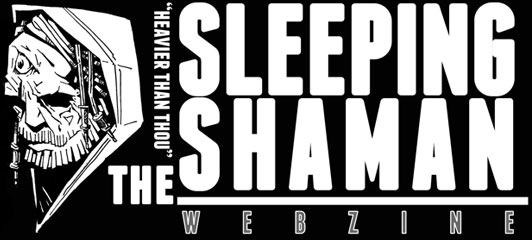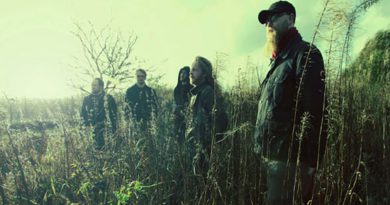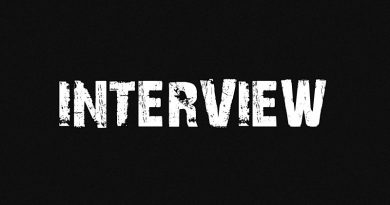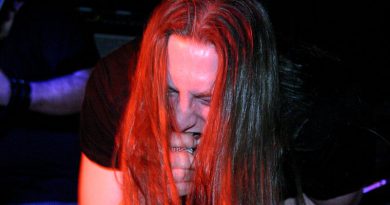In Search Of Tone: Brad Frye Of Red Mesa & Desert Records
I’ve enjoyed every interview I have done to date. This interview with Brad Frye of Red Mesa is definitely one of the most fun interviews I’ve done. It seemed less like an interview and more like two friends sharing their love of music and gear. Not only that, but the first ten minutes of our video chat, Brad was asking ME about MY guitars, and I got to show them off!
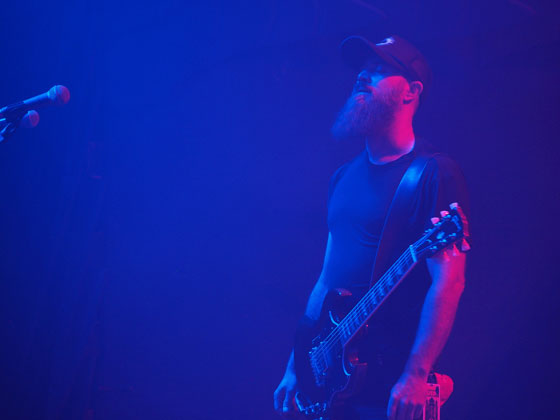
Brad Frye is the man behind the guitar and mic in the epic band Red Mesa. He makes up 1/3 of the band and the trio is a big reason my love for desert rock has grown so much. Brad also runs Desert Records and has some unique and outstanding bands on his label. They recently celebrated their 3rd anniversary and already have achieved so much. I’m looking forward to a promising future.
Well, now that I showed off my guitars [laughs]. Let’s start off with the guitars you’re currently using?
This is my main axe. It’s a Gibson SG Natural Burst and it’s tuned to B standard so there’s a lot of strain on this little fucker [laughs]. I love low tunings. The Devil In The Desert album is tuned to C and then I dropped down to B for The Path Of The Deathless. This guitar is a 2011, so I bought it new and it’s pretty great. It stays in tune pretty well. It’s been my main axe on all the Red Mesa albums.
I did change the pickups because I think what you have in your Epiphone SG are the same 490 and 498 pickups in the Gibson models. I wanted the neck pickup to be a little bit more aggressive, so I switch this out. I don’t know shit about pickups, however, I’ve never changed pickups before in my life and of course I didn’t do it myself either. I had it put in for me and I believe this is a Seymour Duncan 59 humbucker. I don’t know if I can tell much difference to be honest from what was in there previously but, I like it. It’s just enough and it gives it a little more over the top for solos.
It’s strangely in pretty fucking good shape for taking it on the road and all the stuff I’ve done with Red Mesa since I got it and I have one other electric guitar and that’s it [laughs].
This is my main axe. It’s a Gibson SG Natural Burst and it’s tuned to B standard so there’s a lot of strain on this little fucker…
What’s your other electric guitar?
I have an Aria Japanese made guitar from the 70s that’s a Gibson Lawsuit Copy of the ES 335 hollow body and it’s really really well-made. It’s awesome and I won’t take it on the road, but I do use it on the albums as another guitar to double track, do a solo, or write a song completely. I have that tuned to either E or E flat. I used it somewhere on The Path Of The Deathless but it wasn’t the main guitar. It was almost entirely the SG on that album.
Live, when I play local shows I’ll bring the Aria, especially if a song is in a different tuning I’ll use it. That fucking guitar sounds great. It has these old pickups that are hot and sound cool. I don’t know if you’ve played a hollow body live but, as soon as you stop playing you get feedback and you have to cut that volume real quick. A lot of times I’ll be playing and it’ll feedback every other second and then I’m like ‘fuck man’ [laughs], they make a lot of noise and they really pick up that signal.
Other than that, I don’t have any other electric guitars, but I do have an endorsement deal for all the bands on Desert Records through Reverend Guitars. A lot of the guys have gotten really, really fucking cool guitars from them and I think I’ll get a baritone from them at some point
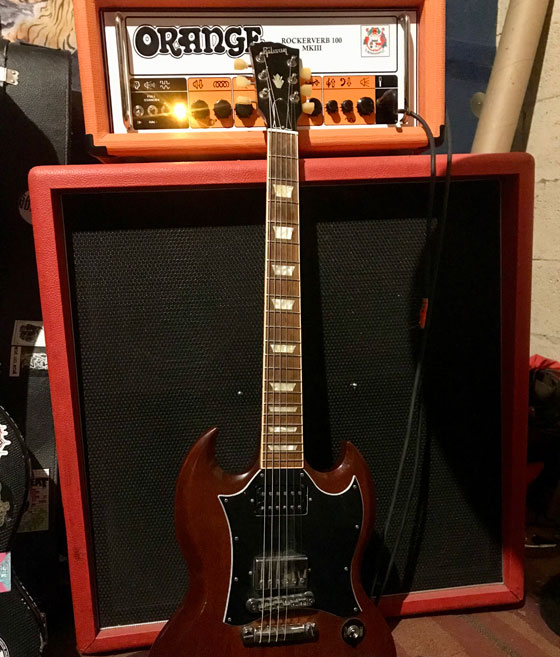
I’ve never played live, this small practice set up is as big as my setup has been. Fingers crossed for live shows one day [laughs].
Fuck yeah, you’re probably a better guitarist then I am.
I very much doubt that [laughs].
A lot of the guitarists at home are just fucking ripping on stuff that I can’t. For me, it’s all about writing a song and I’m not the most technical guitarist, may be the least technical guitarist that you’ll interview. I’m trying to make songs and sounds that sound like they’re from the desert and that’s kind of where I’m coming from for my approach to songwriting. So that for me is a trial and error process and less about the technical aspect of guitar. It’s more like invoking a feeling and an imagery.
When you’re doing acoustic stuff, you have to serve the song and that really taught me that you can’t hide behind a lot of distortion and sustain…
Focusing on the songwriting side. Since I started on an acoustic guitar, I have learned that you can’t hide behind that with effects. When you’re doing acoustic stuff, you have to serve the song and that really taught me that you can’t hide behind a lot of distortion and sustain. When you have a drummer and another guitarist and a bass player, you can do much less on an electric guitar. So for me it’s how do we make music that sounds like it’s from the desert and I don’t know if I’ve succeeded but I’m trying [laughs].
You’re succeeding in my book, I’ve had The Path Of The Deathless on my record player non-stop since I got it and may need another since this one will wear out quickly at this rate [laughs].
Thanks man, that means a lot and I will let the rest of the band know as well. It’s hard to get feedback from fans without touring. We can see the reactions online but it’s not the same unfortunately. We were hoping that it’s kind of a grower of an album. One that we layered with a lot of different sounds and added some really cool guest musicians as well. I really wanted it to be something that people would go like fuck there’s a lot going on the song with the layers, and I was really hoping that it would be a grower and has a lot of depth to it
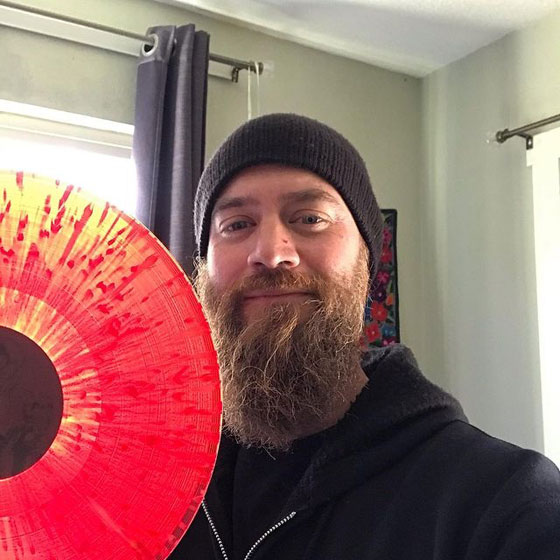
It definitely is. I hear new things each listen and especially now that I have it in on vinyl vs my shitty iPhone 6 speakers. What amps have you been using with Red Mesa?
Up until The Path To The Deathless, my main amplifier was an Ampeg VT-22, which is a 2×12 combo amp from the 70s that was made famous by Keith Richards of the Rolling Stones and I think Josh Homme of Queens of the Stone Age still uses one. It’s extremely loud and clean and has no distortion. It’s really fucking heavy to pick up and I’m so happy to not have that in my life anymore [laughs]. It was a great pedal platform but oh my God it was a two-person haul. I can’t tell you how many times I’d ask somebody to give me a hand and they’ll just say I’ll grab it for you and even some of the real big dudes were like ‘Jesus, what the fuck is inside this thing’ [laughs]. Nobody carried it by themselves. It was 86 pounds of deadweight full of iron, it was just horrible to pick up and the funny thing about it is on the amp itself, it had one fucking handle on the top. I guess the guys in the 70s were just grabbing one in each hand carrying them around like they were nothing [laughs]. But they are heavy.
My main amp now is an Orange Rockerverb 100. I got it while we were recording The Path To The Deathless. On the first fucking day of tracking I had an old Sunn head that I bought from a dude locally and something wasn’t quite right with it. I saw on our local Music Go Round, which is like a used gear store, had an Orange in stock. I know the guys over there and I got a killer fucking deal. I’m so happy to have that in my possession. That thing has got a ton of gain on tap and it still takes a lot of the pedals pretty well, although it doesn’t take any distortion pedals well. I have really good fuzzes, but it doesn’t bring them to life because I think the distortion built in on that Orange overrides it, which I’ve heard from other orange players. That’s been kind of weird trying to figure out my pedalboards because the Ampeg was able to take all kinds of fuzzy distortion pedals. With the Orange, I step on the pedal and don’t hear much difference so I’ve been redoing my pedalboard a little bit.
My main amp now is an Orange Rockerverb 100. I got it while we were recording The Path To The Deathless…
In between the Ampeg and the Orange I picked up this really great combo amp from the manufacture called Budda and he’s the guy who used to do Hiwatt or Soldano stuff. He did his own stuff for a while before he sold it to Peavey and I have one of those pre-Peavey amps. It’s a 2×10 combo 18 watt, so you just dime it. It doesn’t get super loud but you can put it through a 4 x 12 cab. It’s not as loud as I want it, but the tones are great and it’s got a great mid-range and I totally record with that. That’s on a few albums, especially on the The Devil In The Desert. Specifically side one, that is all the Buddha amp with a light overdrive. On the song Desert Sol, that’s all that Budda and sounds fucking killer.
On the last two albums we recorded with Matthew Tobias of Empty House Studios, he has a Marshall JCM 900, a pretty common to amp, but it sounds fucking killer. I’ll play that for the double track to thicken up the guitars and I’ll use a combination of the Marshall and Orange, the Marshall and the Buddha, the Buddha and the Orange or sometimes even all three to really beef up those tracks. Live honestly Josh, I keep it really simple because being in a trio, I’m singing, playing guitar and stepping on all the pedals, the last thing I need to do is have a big set up. I have the Orange 100 watt head and a 4 x 12 cabinet and that’s all I need live. It’s plenty loud for what we do and if we needed something more, for a festival or something, there would be plenty of backline stuff. I don’t do two amp heads or anything, I would like to, but it’s easier to just do one rig.
Through all of these interviews, I’m learning less is more because something will go wrong live.
I have about seven pedals and a tuner and I can’t tell you how many times I’ve had a shitty pedalboard going out on me on every song live. It just throws you off your mojo. If I was a rhythm guitarist in a band with another guitarist, I can’t tell you how excited I would be just to play straight into an amp have a tuner and that’s it [laughs]. I’m tap dancing constantly. I read the article you did with Nick DiSalvo from Elder where he said he’s trying to keep it simple and trying to have all the sound effects on one button that he can just step on, I see a lot of bands trying to do that.
To have some kind of system where you can just step on one button and have all the sounds you need for the each song. I’m not there yet, technologically wise, but I know a ton of bands who do it because each song has its own sound and combinations of different settings of delays, reverb and what not. You can get down a slippery slope pretty quick [laughs] and doing a lot of tap dancing while singing and playing guitar and not having another guitarist. Having a band with three people is really beautiful because you’re free, but at the same time you’ve really got to be on your game.
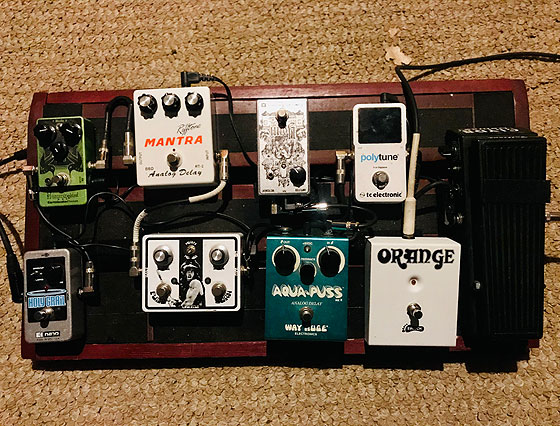
I can see that getting frustrating. You mentioned using about 7 pedals. Could you tell me a little more about them?
I’ve got a wah pedal that goes into my tuner and traditionally I’ve use some kind of light overdrive. Right now, I’m using a boost pedal from Frost Giant Electronics. It’s a Tony Iommi type boost that I got during COVID. I haven’t played it live so I don’t know if I’ll like it or not yet. Well I like it, but I don’t know if it works for what I’m trying to do.
My main delay has been the Way Huge Aqua Puss it’s almost like a chorusy delay and it’s a really friendly, easy pedal to use. I’ve had it on every Red Mesa album and every fucking live show we’ve done. I’ve recently taken it off my pedalboard while I’ve been tinkering around at home, but I don’t know if I’ll keep it off there or not. I do have a Economicon, which is like a delay and reverb pedal from this really cool new company called Fowl Sounds, I’ve been playing around with that, there’s a lot to get into and I’m trying to work it into our sound. I have an Earth City Sounds Mantra delay which is a really cool Pink Floydish kind of delay. It has a longer delay and that I’ve been playing around with recently.
For tremolo I have had the Earthquaker Devices Hummingbird for years which is a very choppy and percussive delay. I like it because you can feel it. It almost gives you that seasick feeling [laughs]. You can hear that on the song The Devil In The Desert in the middle of it ‘into the desert I go, into the desert I go, to lose my mind and find my soul’ that’s that sound on there and I use it live as well. I’ll play it with certain stuff throughout the show. For reverb I love the EHX Holy Grail Nano. I’ve been using it for years and the Flerb setting is the sound on The Devil In The Desert at the beginning. That’s the weird kind of swirling sound. I use it also on the beginning of The Path Of The Deathless. That Flerb setting, I fucking love it and that’s that’s pretty much it on my board.
My main delay has been the Way Huge Aqua Puss it’s almost like a chorusy delay and it’s a really friendly, easy pedal to use. I’ve had it on every Red Mesa album and every fucking live show we’ve done…
And your gain is now coming mostly from the Orange Rockerverb?
Yes I just use gain from the Orange. The fuzz pedals I have I love. I have a Black Arts Toneworks Pharaoh Fuzz, but I took it off the pedalboard because it clashes with the Orange so I just didn’t need it, but I love it. I love Mark from Black Arts Toneworks. I got the Women Of Doom pedal, which is a custom pedal I did with Mark for the Women Of Doom project that involves Desert Records, Blues Funeral, Black Arts Toneworks and the artwork was used from Laura from Subterranean Prints. I bought the pedal and gave it to all the artists as a gift and had a couple leftover. I had people asked me for more and I made another batch of 20 and I just sold the last one today.
I’ve never heard of a record label do a pedal release and it seemed like a cool idea, so I wanted to try it. I think I’m going to do more of that because it’s so fucking fun [laughs], the Women Of Doom pedal rules and I’ve been playing with it, but it also competes a little bit with the Orange, so maybe from this interview someone out there will be like ‘you’re a fucking idiot bro, you need to do it this way’. So, we’ll see if anybody pops up on how to use heavy distortion pedals on a gainey Orange Amp as there might be some gearheads out there who can help me out. The pedal has a heavy low grind that works well on bass also. Jessica from Sorcia, a really cool band from Seattle (who I just signed by the way) bought one for her bass rig, sent it to me and the whole fucking phone was shaking from the monster bass so that was really cool.
Oh and I have this fuzz pedal! I love this fucking pedal [holds pedal to camera]. Its killer dude. The fuzz and burn is a really gnarly heavy fucking fuzz. The fuzz sounds awesome and you can switch down to a heavier sound. The volume knob is just called ‘sludge’ plus it has Conan the Barbarian on it [laughs]. This pedal rules and that’s the sound, through the Orange amp thats on the title track The Path Of The Deathless. Its made out of Greece by Minotaur Effects and the guy rules. He makes cool fucking pedals. He sent it to me with 9 million stamps on the fucking box [laughs]. It’s just an incredible pedal and a lot of heavy players are using this guys stuff. I was playing it through this tiny little fender amp making this thing sound like a fucking fuzz box.
So that was kind of a random smattering of pedals that I was using, but really for me it’s just finding one or two dirt/fuzz pedals that I like, a really good delay setting that I like live, because pretty much every solo I play I’m going to have some delay on it and having some additional reverb flurry for the desert and the spacey stuff, and a tremolo and wah. I’ve played with a Dunlop Cry Baby and right now I have a Fulltone Clyde although I’m not a very good wah player [laughs].
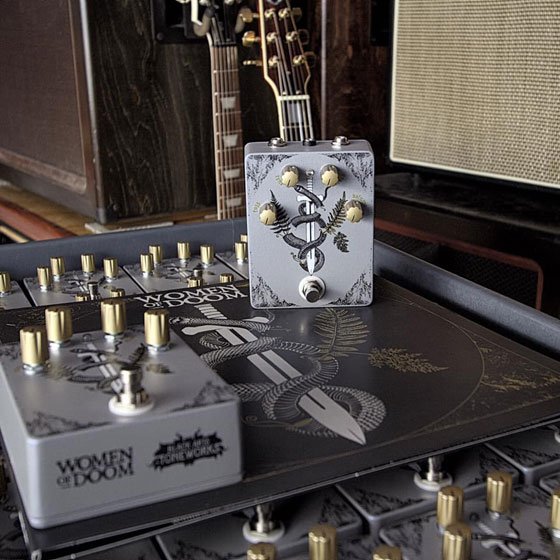
I bought a used Vox wah pedal years ago and I couldn’t get it to sound good and looking back I’m thinking it was broken. Or I couldn’t figure it out [laughs].
Yeah, I’ve played through a broken wah before. I actually played one for about four years in the studio and live and didn’t know it was broken [laughs]. So yeah I know what you mean. Some people are amazing wah players and I just always found them strangely frustrating. I never got them to sound the way that I expect them to sound so I’m assuming that’s all me. I put it right in the front of everything like all the pedal forums tell you, to start with a wah. Maybe I should try it in another spot.
I like wah a lot and some of my favorite guitar solos of all time have wah on them, but I’ve never been able to emulate anything close to that [laughs]. I think the wah pedal is good for creating a riff, or using it to add to a song, but I wouldn’t necessarily consider a wah an essential song writing tool. Again, that’s just me. There are other guitar players that may think otherwise but that’s the beautiful thing, there are no rules.
I’ve never been interested in nerding out too much, I just find things that work for me and some pedals are too complicated. I try and find things that work well live, other than that I’d rather work on a song then work on figuring out a pedal.
I’ve played through a broken wah before. I actually played one for about four years in the studio and live and didn’t know it was broken [laughs]…
Speaking of writing a song. What is your writing process like?
Probably like most people in the heavy music world, where it’s really more about the riff first and creating the music. I wish I could write the other way because I really love stuff that is obviously vocally and melodically written and driven. However riffs and chord progressions are usually written first and vocals are added over that.
With a finite about of chords and notes, how do you go about creating unique music?
It’s the biggest challenge. I don’t know much about music theory. I can’t read music. I really like the harmonic minor scale, which has maybe one or two more notes on the pentatonic scale. I kind of work in that when creating riffs. It’s very easy to stumble on stuff because there’s so much guitar music these days and we all listen to so much of it. There’s so many great players, so many great songs and so many great riffs that I think that actually attempting not to play something that’s done is difficult. I go through the process of 1 – Does that feel good to play, 2 – Does it sound cool, 3 – Is it original and 4 – Can I sing over it [laughs], those are the four boxes I really try and check when writing a riff.
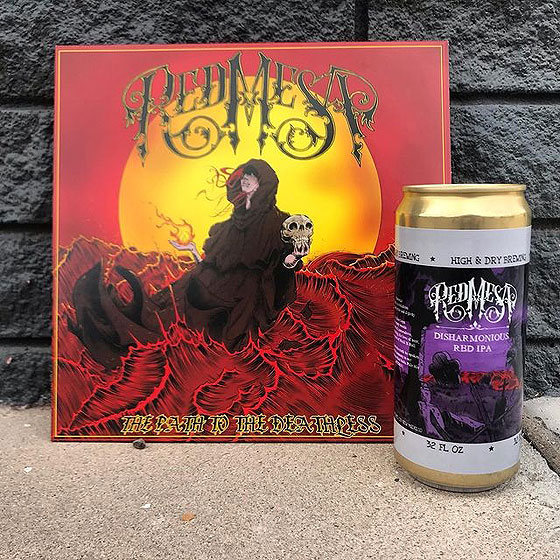
I have many off days and often get discouraged and stop playing. What do you do if you have an off day?
I have more off days and on days I think. I work pretty slow Josh, I’m not very prolific and for me it’s a lot of muscle memory. If I like playing the riff and I have it in my head later, that’s cool. I don’t try and pressure myself too much in terms of writing. I’ll kind of chip away at song ideas and record them into my Voice Memos on my phone at the most basic level. If I still like the riff, the next thing would be to bring it to the band and especially see how Roman drums over it and if Roman likes it.
The philosophy with Red Mesa and the writing process is that nothing is finished, done or agreed-upon until we all agree it feels good together…
The philosophy with Red Mesa and the writing process is that nothing is finished, done or agreed-upon until we all agree it feels good together. I can bring an idea and think this is the best fucking thing in the world and when we play it, realize it sucks because until you put the band on it, you don’t really know whether the riff will either come alive or die. I’m always surprised about what works and what doesn’t with a band versus what I wrote on the couch [laughs]. So it’s a slow process. I also have ideas I’ll hold onto for years and just wait for the right time to use them.
The Path Of The Deathless riff for example, I’ve had for about 12 years but I knew it was going to be on something and I’ll do that. I’ll sit on something for a long time. Another example is the song Death I Am, I didn’t do the music, that was my friend Steve Schmidlapp. He plays in two local bands Pray for Kali and Blue Heron, he’s a phenomenal guitarist, he wrote that song and I put down the lyrics and vocal melody. We had that for six years and I played an old recording that I had for the band and they thought this has to be on the record. So I brought Steve in to the studio, he played the acoustic guitar and I brought in Alex McMahon from The Grahl Brothers to put down lap steel. I’ll save ideas until I feel like they’re ready to become a song, and then there’s a lot of stuff I’ll just throw away or end up playing again later without knowing it [laughs].
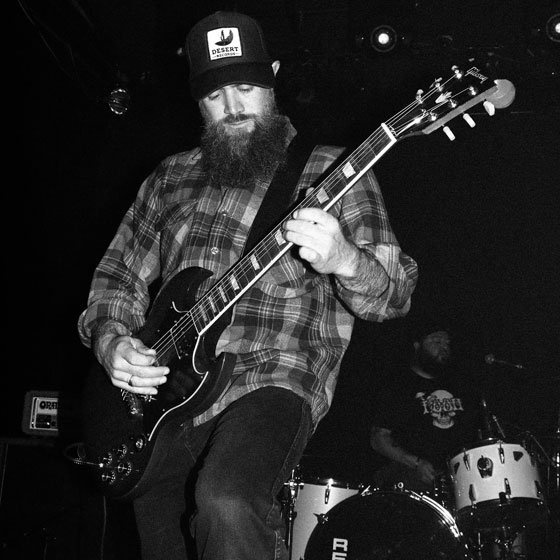
Very cool, do you go into the studio with the mindset of how will we play this live?
By the time we get to the studio we have practiced the songs together many times. I know that I could play the song live, but in the studio I don’t worry about if I can replicate parts or the sound live because the studio is a whole different thing. There are songs that I’ve recorded with Red Mesa that I cannot play live, but most of the stuff we already know is going to be a part of our live set. Especially if it’s something more intricate with a few guitar parts or maybe a lap steel, then I definitely can’t be doing all that live. I try to make the guitars interesting as possible with enough effects that I can do live so I can try and get the studio recording close to that. You’ll never truly get that perfect, so we pretty much know what our live sets are going to be. We sometimes do some spontaneous stuff in the studio, but 90% of it is done before we get there
By the time we get to the studio we have practiced the songs together many times…
I love when bands change up song arrangements live. Is that something you guys do?
Yeah, a lot of the older Red Mesa stuff off the Self-Titled, we switch up because we have a different rhythm section now, but I don’t really know about the new stuff yet. We haven’t really had a chance to play that live too much but I do know the song Swallow By The Sea is a really rad song and is mostly written by Alex and Roman. We will take out the intro part with the violins and will just go straight into the song. So sometimes we condense songs. On the other hand, in the Red Mesa realm we will extend parts and just jam out way longer than we did on the album, especially if we’re feeling real good and we’re in the zone. Live we’ll just start stretching out, letting it go for a while and we can look at each other and think let’s wrap it up. So live we tend to jam out a little bit which can be good and sometimes it sucks [laughs].
Do you have any practice routines you do on a daily basis.
No I don’t really have a practice routine. I usually start playing and will practice on a song or something I don’t know. I don’t have any sort of particular thing that I do sorry [laughs].
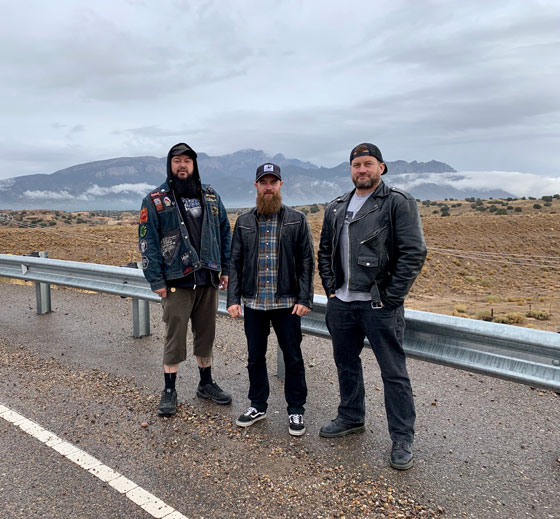
No, that’s the most common answer and after doing these interviews I feel a lot better because I thought I should be practicing daily and I don’t always do that either.
I did see that Kyle from The Sword warms up as I’ve been reading your In Search of Tone interviews, it’s a really cool fucking project.
Thanks, that means a lot, yeah I think he may be the only one.
It’s amazing how creative so many people and bands are with zero music theory. It’s mind boggling as a lot of these dudes that I’ve been jammin with for years have a phenomenal ear but they couldn’t talk to you about music theory. I don’t have the best ear, but I focus more on compositions, songwriting and a vision for song. I’m not a very good guy to sit around and start jamming where a lot of guys can just jump in and play. For me, I have to understand more of where the song is going. When I write I try and get a lot of stuff written that I can present to the band and say ‘what can we add to it’, but in terms of sitting around jamming, I feel like, at least for me, it’s fun for a little bit but it’s not constructive to write a song.
I have to play parts over and over until they start to sound good and become a bigger thing, but there are so many guys that would jump in and jam with Red Mesa and it’s like ‘whoa dude fuck, you’re playing along like it’s nothing, it took me two years to write that song and you’re jammin it in 15 seconds’ [laughs]. That’s really impressive. I remember reading about Slash as a boy and it was the first time that I ever really acknowledged that topic with musicians. He doesn’t know music theory and couldn’t teach guitar; he just plays it and he’s an amazing guitarist.
I do feel however, lessons are important for a guitar player at any level. Guitar lessons are important at a certain point and you can only teach yourself so much. You’re learning whether you’re looking up how to play a song on YouTube or something like that, but I do feel lessons are important. Isaiah Mitchell from Earthless has hands-down got to be one of the best guitarists of our generation. I would take guitar lessons from him. I think his style is wicked. Its a heavy psychedelic blues, I love that style and he could solo forever, but he knows what he’s doing and he writes amazing music. Also Jeff Metz from High on Fire, he plays random weird folk and traditional instruments who does lessons as well.
It’s amazing how creative so many people and bands are with zero music theory….
There are so many amazing musicians in heavy rock right now and getting into the state of rock ‘n’ roll, it is firmly entrenched in the underground. Rock ‘n’ roll’ is not mainstream anymore but it’s had a phenomenal creative resurgence, especially in the last five to ten years. Unfortunately, not a lot of people are hearing it and the numbers are way down.
It’s really refreshing to see bands like Elder or The Sword to get up in the upper echelon of the underground music and breakthrough a little bit. High on Fire won a fucking Grammy. I’m happy to see more recognition for these bands because, for me, it’s not about my band or the bands on Desert Records, it’s rock music as a whole as takes certain bands to kind of pull people up from the underground, but there’s hope. It’s a different time now where everybody and anybody can put their music on a streaming service and pay for digital streaming to put their album out.
How does a listener trying to find rock ‘n’ roll music even start because it’s overwhelming and I think that’s the important part of a record label. You can be a voice and say this is good music that I’m putting out and that, to me, is why I’m doing Desert Records because it’s a guideline where people can check out what the labels putting out, versus what the band is putting out and I got some weird stuff coming out this year. I’m not trying to do just straight up metal or rock, I’m just trying to broaden the spectrum a little bit and have some pretty cool stuff coming out.
That all sounds exciting! Thanks Brad for spending the time discussing the many aspects of creating music, thank you for all the hard work you’re doing and keeping the world of rock and roll very much alive.
Label: Desert Records
Band Links: Facebook | Bandcamp | Twitter | Instagram
Interviewed by: Josh Schneider
